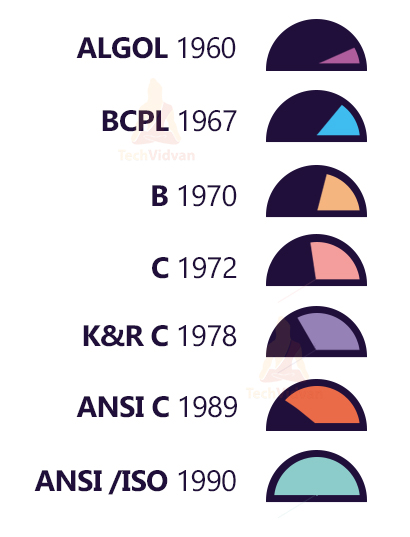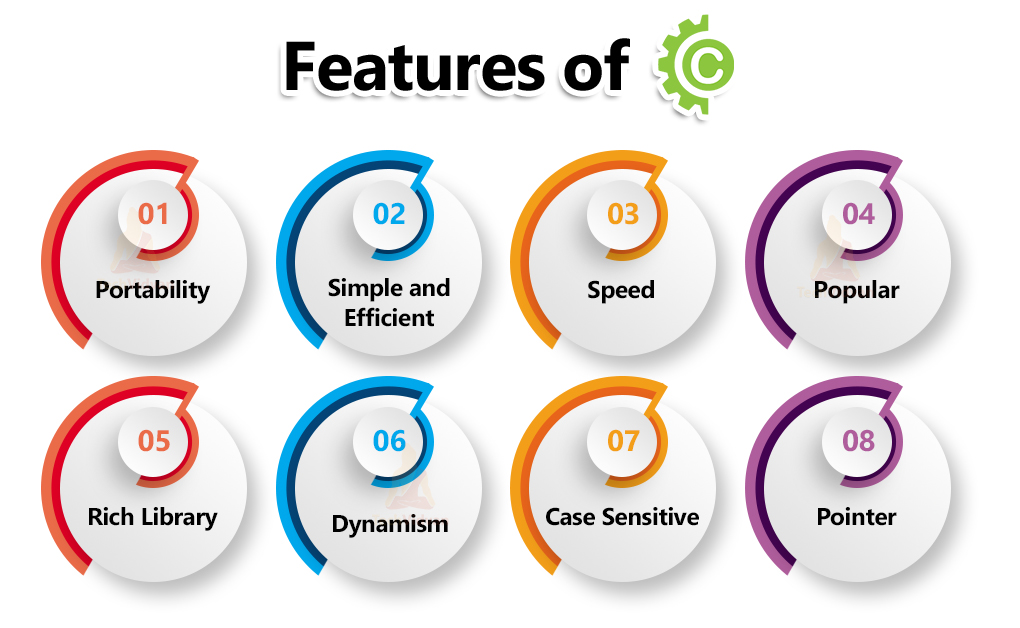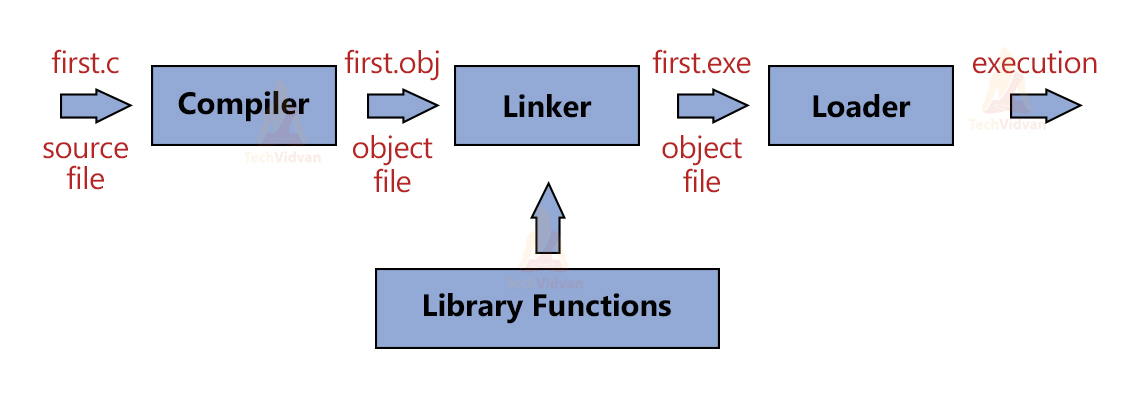What is C – Introduction to C Programming Language
C programming language is a procedural and general-purpose programming language. It is fast and simple to learn and implement. It was developed by Dennis Ritchie in the year of 1972.
The c programming language offers various features and functionalities to the programmers. It includes low-level memory access, simple syntax, and a clean style. It makes the C programming language suitable for system programming like compiler development and operating system development.
After C, several programming languages like PHP, JavaScript, Java, and many others have borrowed the syntax and the features directly or indirectly from the C language.
If someone wants to learn a programming language then he/she should start learning the C programming language in the first place. C is the base for programming.
History of C programming language:-
The father of programming languages is ALGOL. It came in the year 1960. With the help of ALGOL, the developer community learned about the concept of structured programming language.
In the year of 1967, a new programming language named BCPL was introduced. BCPL stands for Basic Combined Programming Language. It is specially used for writing system software.
After 3 long years, a new programming language called B was created by Ken Thompson. It contained multiple features of BCPL. These two programming languages such as B and BCPL were also known as system programming languages.
In 1972, a great computer scientist named Dennis Ritchie created the C programming language. It includes all the features of B, BCPL, ALGOL, and many more additional features too. That’s what makes it unique compared to these languages. Most of the UNIX operating systems are created using the C language.
Nowadays, the C is used on a variety of operating systems and hardware platforms. In the year 1990, C was approved by the International Standards Organization(ISO). C language is also known as ‘ANSI C’.
Structure of C programming language:-
Following is a basic example of C language:-
| Commands | Meaning |
| #include<stdio.h> | It helps you to include the stdio.h header file into your program. With this, you can perform input/output operations. |
| int main() | From here the execution of the C program starts. It is the main() function. |
| { | Used for indicating the beginning of the main() function. |
| /* comments */ | If you write something inside this ‘/* */’ then it won’t get executed. |
| printf(“Hello World”); | Used for printing the output to the screen. |
| return 0; | Used for terminating a C program and it returns 0. |
| } | Used for indicating the end of the main() function. |
Including header files:-
In a C program code, at first you have to include a header file. To execute the program, you must include a header file into your program code.
Below are some of the header files:-
- stddef.h – Used for defining various types and macros.
- stdint.h – Used for defining exact width integer types.
- stdio.h – Used for defining input and output functions.
- stdlib.h – Used for defining numeric conversion functions, pseudo-random network generator, memory allocation.
- string.h – Used for defining string handling functions.
- math.h – Used for defining mathematical functions.
Main Method Declaration:-
In C, you will have to declare a main method after including the header file.
Syntax:-
int main()
{}
Variable Declaration:-
Next, you have to declare some variables to start with the program code. In C, you cannot use any variables if you have not declared it first.
Example:-
int main(){
float a;
int f;
Body:-
In body, you write codes to perform a specific task or operation such as manipulations, searching, sorting, printing etc.
Example:-
int main(){
float a = 2.3;
printf("%d",a);
Return Statement:-
It is the last part of each and every C program. It depends on the return type of the function. Return Statement is used for returning values from a function. If the return type is void then you don’t have to write the return statement in the program code.
int main(){
float a = 2.3;
printf("%d",a);
return 0;
}
Real-World Applications of C
The use of the C programming language is not limited to the development of operating systems and applications. It is also used in GUI development, IDE development etc. Some uses of C language are:-
- Operating Systems
- Assemblers
- Text Editors
- Print Spoolers
- Modern Programs
- Databases
- Utilities
Hold Tight, because I am going to tell you some exciting real-world applications of C.
1. Operating Systems:-
With the help of C, you can write your own operating system. Isn’t it cool? The C programming language is used to develop windows and linux kernels and also the Apple OS X kernel.
2. Graphical User Interface:-
It stands for Graphical User Interface. Apart from creating operating systems, C is also used to develop popular adobe softwares such as photoshop, premier pro, After Effects etc.
3. Embedded Systems:-
In daily life, we use different embedded systems like coffee machines, microwaves, climate control systems etc. C makes it easy to develop these systems.
4. Database:-
Popular database management software, MySQL was developed using the C programming language.
5. Ease of Computation:-
C provides faster computation in programs. The implementation of algorithms and data structures is swift in C. With the help of C, you can perform high degree calculations such as MATLAB, Mathematica etc.
6. Gaming:-
C programming is relatively faster than Java or Python. C language has been used in various gaming applications and graphics. Many popular games like Tic-Tac-Toe, The Snake game, Sudoku etc. are developed using the C language.
7. Development of New languages:-
The C language is fast and easy to understand. So many programming languages like Java, Python, PHP etc. get influenced by this. Even the libraries of Python are developed using C. The syntax and control structures of PERL, PHP and C++ are based upon the C language.
8. Assemblers:-
Assemblers are mainly used to translate assembly level language to machine level language. C also helped in developing GNU assembler.
9. Text Editors:-
C also helped in creating various text editors like Vim, Gedit etc.
10. Interpreters:-
You can also create language interpreters using the C programming langauge. C helped in developing different programming language interpreters like Python and MATLAB interpreters etc.
11. Compiler Design:-
C also helped in designing several popular compilers like Clang C, MINGW, Apple C etc. This is one of the most popular uses of C language.
Features of C:-
1. Portability:- In C, you can execute a block of code in different environments. Suppose, you create a program in one platform and you are running or modifying the program in other platforms. Portability is one of the best features of the C language.
2. Simple and Efficient:- The C programming language is easy to implement. The syntax of the C programming language is easy to understand. If you are confused about which programming language you should learn as a beginner then the C programming language is the best choice for you. It is efficient and simple to learn and use.
3. Speed:- It compiles and executes faster than Java or Python. Because C is a compiler based programming language and Java and Python are an interpreter based programming language.
4. Popular:- The C programming language is used in making operating systems and embedded systems. It is one of the most widely used programming languages in the world.
5. Rich Library:- The C programming language has a rich library which offers useful built-in functions. Apart from these functions, you can also add or define user-defined functions to the library. These functions help in solving numerous types of problems easily and also help in better and clean coding.
6. Dynamism:- The C programming language supports dynamic memory allocation. It is used for utilizing and managing memory. C library has some functions such as malloc(), calloc(), free() etc. to perform dynamic memory allocation.
7. Case Sensitive:- C programming language is case sensitive. If we declare two variables such as “X” and “x” as an integer then the C language treats these two variables differently.
8. Pointer:- Pointer is one of the most useful features in C. With pointers, you can work with the memory in C. You can also use pointers with arrays, structures, functions etc.
9. Recursion:- In C, you can define a function inside of a function. This technique is called Recursion. This will help you in code reusability.
10. Middle-Level Language:- It has features of high-level languages and it has capabilities of assembly language.
11. General-Purpose Language:- The C programming language is being used in various domains like photo editing software to system programming. Also, it is used to develop databases such as MySQL, PostgreSQL, Oracle etc.
Why is C popular?
The C programming language has left marks in pretty much every area of Science and Technology. C is easy to understand and the syntax of the C language is simple. That’s what makes C popular. Almost every renowned and successful programmer is very much familiar with the C programming language.
C language has a vast collection of built-in functions which will make your coding a lot easier. It also supports dynamic memory allocation. This is a compiler-based programming language. It is faster than interpreter-based languages like Java or Python.
Working of C programming language:-
The C programming language is a compiled language. A compiler first compiles the program code and then it converts it into the object code which is machine-readable. Then the linker will combine different object files and it produces an executable to run the program.
Following is a diagram of executing a C program code.
Below is the list of some compilers:-
- Clang Compiler
- MinGW Compiler
- Turbo C etc.
Why you should learn C:-
As we said earlier, the C programming language is the base for programming languages. Nowadays, the C programming language is being used widely all over the world. The C language is a faster and much simpler language. C language is also known as a structured programming language. That’s why C is easy to debug and test.
The C programming language contains 32 keywords, a set of powerful built-in functions, several data types which makes the C very useful and powerful. In C, you can also make use of user-defined functions. This helps you with complex programming.
What is a Compiler:-
You can say that a compiler is a computer program that is used for converting the program code to machine understandable code. It is software that converts the code to machine-friendly language.
The high-level language is machine-independent and is human readable. So, we have to convert a low-level language to a high-level language. Through compilation, a high-level language gets converted to a low-level language.
Advantages of C:-
1. Portability:- In C, you can execute a block of code in different environments. Suppose, you create a program in one platform and you are running or modifying the program in other platforms. Portability is one of the best features of the C programming language.
2. Simple and Efficient:- The C programming language is easy to implement. The syntax of the C language is easy to understand. If you are confused about which programming language you should learn as a beginner then the C language is the best choice for you. It is efficient and simple to learn and use.
3. Speed:- It compiles and executes faster than Java or Python. Because C is a compiler-based programming language and Java and Python are interpreter-based programming languages.
4. Popular:- The C language is used in making operating systems and embedded systems. It is one of the most widely used programming languages in the world.
5. Rich Library:- The C language has a rich library that offers useful built-in functions. Apart from these functions, you can also add or define user-defined functions to the library. These functions help in solving numerous types of problems easily and also help in better and clean coding.
6. Recursion:- In C, you can define a function inside of a function. This technique is called Recursion. This will help you in code reusability.
7. Structured/Modular Programming language:- In C, you can break the program into small blocks of code with the help of a function. Instead of writing a long and complex code, you can divide the program into small blocks of code as functions then you can perform multiple tasks such as finding the area of square, rectangle, circle etc. A function is used for code reusability.
Summary:-
In this tutorial, we learnt what C programming language is. Then we discussed its history, structure, features and applications of the C language. We discussed why you should learn C. We also talked over the popularity of the C language.



